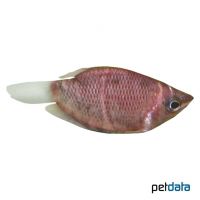Chocolate Gourami (Sphaerichthys osphromenoides)
| Chocolate Gourami Sphaerichthys osphromenoides | |
|---|---|
| Name | Chocolate Gourami |
| Name Lat. | Sphaerichthys osphromenoides |
| Family | Gouramies |
| Family lat. | Osphronemidae |
| Order | Labyrinth Fishes |
| Order lat. | Anabantiformes |
| Origin | Southeast Asia |
| Habitat | Streams, swamps |
| Diet | Omnivore |
| pH | 4.0-6.5 |
| Behavior | Peaceful |
| Keeping | Pair, group |
| Care Level | Experts only |
| Reproduction | Mouthbrooder |
| Breeding | Difficult |
| Life Span | 2-3 years |
| Protection | No |
| Metric Units | |
| Size | 6 cm |
| Temperature | 24-30 °C |
| Hardness | 1-3 °dH |
| Aquarium | ~ 120 l |
| US Units | |
| Size | 2.4" |
| Temperature | 75-86 °F |
| Hardness | 18-53 ppm |
| Aquarium | ~ 30 gal |
Distribution and habitat
The distribution area of the chocolate gourami is the Malay Peninsula, Sumatra and Borneo. There they live in shady, slow-flowing streams and peat swamps with decaying foliage, dead wood and roots.
Maintenance
The aquarium should have dense planting with many hiding places (roots, stones, caves). A dark, sandy-soft substrate, covered with mulm and foliage (e.g. sea almond leaves) as well as subdued light (floating plant cover) is ideal.
No ammonia, ammonium and nitrite should be detectable, the nitrate value should not exceed 100 mg/l. To ensure the water quality and oxygen content, a filter and heater adapted to the aquarium size is required, as well as lighting for the species-appropriate day-night rhythm of the animals.
Diet
They require mainly animal food, supplemented with algae. The food supply consists of small live foods, such as daphnia, cyclops, artemia and mosquito larvae, which are usually also eaten in frozen form, supplemented with commercially available, frozen special food mixtures. After habituation, high-quality dry food (flakes, granules) with high vegetable content (e.g. spirulina, kelp) is also accepted
Only as much should be fed as is eaten within a few minutes. A regular and varied diet promotes health and prevents deficiency symptoms.
Behaviour and compatibility
These peaceful and shy fish, which move slowly, should only be socialized with other very calm fish that are not food competitors. They should be kept in pairs, but better in a group of about 6
Basically, only compatible fish species with similar requirements for water conditions and water temperature may be socialized.
Sex dimorphism
Outside the spawning season, the sexes are hardly distinguishable.
Reproduction and breeding
The female takes care of the mouth brood (maternal mouth brooders). Mating takes place near the ground and can last several hours. The eggs laid on the bottom by the female (10-40 eggs) are picked up by the female in her throat pouch for further mouth brood care. After 7-20 days, the fry are released and brood care ends. During this time the female hardly eats any food.
The fry must be fed several times a day with special rearing food (dust food, Artemia nauplii). In a community tank breeding is hardly possible, because the fry are easy prey
Important
They have an additional respiratory organ, the so-called labyrinth (suprabranchial organ) with which they breathe atmospheric air and can suffocate if this is not possible. The air temperature in the breathing area must not be below the water temperature!
The well-being of the fish should be checked regularly. The temperature should be checked daily, the pH, hardness and nitrate value at least every 14 days. A regular partial water change is recommended, even if the pollutant load has not yet reached the upper limit. Sudden changes in water quality should be avoided. Newly introduced fish must be accustomed slowly to the water in the aquarium.
Further literature can be found in your pet store.
References
Text: Werner Winter; Image: petdata
Source: BMEL (1998): Tierschutzgutachten - Haltung von Zierfischen (Süßwasser); RIEHL & BAENSCH (2006): Aquarien Atlas Bd. 1, Mergus Verlag; ENGELMANN (2005): Zootierhaltung - Tiere in menschlicher Obhut: Fische, Verlag Harri Deutsch
- Gemäß § 21 Abs. 5 Tierschutzgesetz idgF
